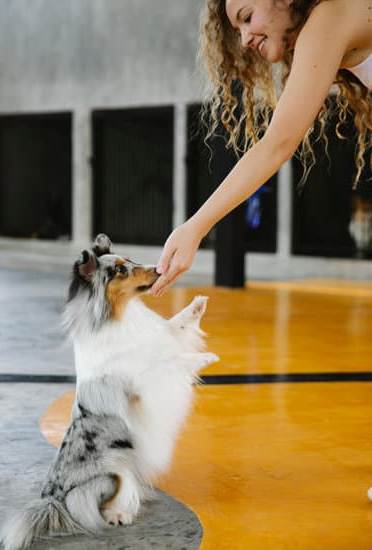How do they train service dogs to assist individuals with disabilities? Service dogs play a vital role in providing assistance and support to people with physical and cognitive disabilities, but their training process is often shrouded in mystery. In this article, we will delve into the world of service dog training, exploring the selection process, basic and specialized training techniques, ethical considerations, and the profound impact these furry companions have on the lives of those they serve.
Service dogs are more than just pets; they are highly trained partners that provide essential help to individuals with disabilities. From guiding the blind and alerting the deaf to assisting with mobility and performing specific tasks, service dogs are meticulously trained to meet the varied needs of their handlers. The process of selecting, training, and certifying these remarkable animals involves a combination of dedication, patience, and expertise.
In the following sections, we will take an in-depth look at the different facets of service dog training – from the specific tasks they perform to the methods used in their training. We will also discuss the importance of ongoing training and certification for service dogs, as well as share inspiring stories of how these devoted companions have made a positive impact on the lives of those they serve.
Join us as we uncover the fascinating world of service dog training and understand how it contributes to enhancing the quality of life for individuals with disabilities.
The Role of Service Dogs
Service dogs play a crucial role in assisting individuals with disabilities, providing them with support, independence, and companionship. The tasks and responsibilities of service dogs are varied and tailored to meet the specific needs of their handlers. Some of the common duties that service dogs are trained to perform include:
- Guiding individuals who are blind or visually impaired
- Alerting individuals who are deaf or hard of hearing to important sounds
- Retrieving items for individuals with mobility limitations
- Assisting individuals with psychiatric disabilities by providing comfort during emotional distress
- Detecting impending seizures or changes in blood sugar levels for individuals with epilepsy or diabetes
The selection process for service dogs is meticulous, taking into consideration factors such as temperament, behavior, intelligence, and physical traits. Once selected, the basic training techniques for service dogs typically involve teaching fundamental commands and skills such as sitting, staying, walking on a leash without pulling, and coming when called.
In addition to these basic training techniques, service dogs undergo specialized training to perform specific tasks based on their intended roles. This includes guide dog training for navigating obstacles and traffic for the blind, training hearing dogs to alert their handlers to sounds such as doorbells or alarms, and teaching mobility assistance dogs to open doors or retrieve objects. These specialized skills ensure that service dogs can effectively support individuals with disabilities in their daily lives.
The Process of Selecting a Service Dog
Breed also plays a significant role in the selection process, as certain breeds are better suited for specific tasks due to their natural instincts and physical characteristics. For example, Labrador Retrievers and Golden Retrievers are commonly chosen as guide dogs for individuals who are blind due to their intelligence, gentle nature, and ability to focus.
Additionally, the overall health and age of the dog are taken into account to ensure that they can handle the rigorous training process and provide many years of service.
It’s important to note that while breed and specific qualities are considered during selection, each dog is also evaluated as an individual. Not all dogs within a certain breed will be suitable for service work, so thorough assessments and evaluations are conducted to determine which dogs have the potential to succeed in service training. This careful selection process ensures that each service dog has the right qualities and abilities to fulfill their important role in assisting individuals with disabilities.
| Factor Consideration | Details |
|---|---|
| Temperament | Calm, well-mannered behavior |
| Breed | Consideration based on natural instincts and physical characteristics |
| Overall Health and Age | Evaluation of ability to handle training process and provide many years of service. |
Basic Training Techniques
Service dogs undergo extensive training to prepare them for the important role they play in assisting individuals with disabilities. The basic training techniques are fundamental in laying the groundwork for the service dog’s ability to perform their tasks effectively. These techniques include:
- Obedience commands: Service dogs are taught essential obedience commands such as “sit,” “stay,” “come,” and “heel” to ensure they can respond reliably to their handlers’ instructions.
- Leash training: Proper leash manners are crucial for service dogs, as they need to navigate various environments while maintaining control and focus on their handler.
- Socialization: Service dogs are exposed to different people, animals, and environments during their training to ensure they remain calm and well-behaved in various situations.
In addition to these basic training techniques, service dogs also receive specialized instruction tailored to the specific tasks they will be performing. This may include advanced obedience commands, task-specific skills, and exposure to scenarios relevant to their future role.
The trainers who work with service dogs utilize positive reinforcement techniques to encourage desired behaviors and create a strong bond between the dog and its handler. This approach not only ensures the well-being of the animals but also promotes effective communication and teamwork between the service dog and its owner.
Specialized Training for Specific Tasks
Service dogs undergo specialized training to perform tasks that cater to the specific needs of individuals with disabilities. Guide dogs, for example, are trained to assist individuals who are blind or visually impaired by navigating obstacles and providing directional cues. These dogs learn to stop at all elevated curbs, steps, and changes in elevation, ensuring the safety of their handlers.
Hearing dogs are trained to alert individuals who are deaf or hard of hearing to important sounds such as doorbells, smoke alarms, and ringing telephones. These dogs are taught to make physical contact with their handler and then lead them to the source of the sound when it occurs.
Mobility assistance dogs provide support and assistance with various mobility-related tasks for individuals with physical disabilities. They can be trained to retrieve dropped items, open doors, operate light switches, and even assist with tasks such as transferring from a wheelchair to a bed or chair.
The specialized training for these specific tasks involves intensive instruction to ensure that service dogs can effectively meet the unique needs of their handlers. Not only do these highly trained dogs provide practical assistance, but they also offer emotional support and companionship to enhance the independence and well-being of individuals with disabilities.
| Task | Description |
|---|---|
| Guide Dogs | Assist visually impaired individuals with navigation and obstacle avoidance |
| Hearing Dogs | Alert deaf or hard of hearing individuals to important sounds |
| Mobility Assistance Dogs | Provide support with various mobility-related tasks for individuals with physical disabilities |
Socialization and Public Access Training
Environmental Exposure
Socialization and public access training are crucial aspects of service dog training. During this phase, the dogs are exposed to a wide range of environments and experiences to ensure they are comfortable and well-behaved in various situations. This includes introducing them to crowded areas, loud noises, different surfaces, and unfamiliar people and animals. By familiarizing the service dogs with these environments, they can develop the confidence and adaptability needed to accompany their handlers in public spaces.
Behavioral Conditioning
In addition to environmental exposure, socialization and public access training also involve behavioral conditioning. Service dogs are taught how to behave appropriately in different settings, such as remaining calm and focused amidst distractions or navigating through crowds without causing disruptions. They learn to ignore temptations like food on the ground or attention from strangers while staying attentive to their handler’s commands. Through consistent reinforcement of desired behaviors, service dogs become reliable companions in public spaces.
Legal Rights and Responsibilities
As part of their socialization and public access training, service dogs also learn about their legal rights and responsibilities. Trainers work with handlers to educate them on the laws pertaining to service dogs, including where they are allowed to accompany their handlers and the behavior expected of them in these places. This ensures that both the handlers and their service dogs can navigate public spaces confidently while adhering to regulations governing service animals.
The thorough socialization and public access training that service dogs undergo is essential for preparing them for their vital role in supporting individuals with disabilities in various everyday settings. Mastering these skills allows service dogs to seamlessly integrate into society while providing valuable assistance to their handlers.
Training Methods and Ethical Considerations
When it comes to training service dogs, there are various methods used to ensure that these animals are able to perform their duties effectively. Positive reinforcement techniques are commonly employed, where the dogs are rewarded for exhibiting the desired behavior. This can include treats, toys, or verbal praise. The use of force or punishment is generally avoided in service dog training due to its potential negative impact on the dog’s well-being and performance.
Another important aspect of training service dogs is ethical considerations in animal welfare. Trainers and handlers must prioritize the physical and emotional well-being of the dogs throughout their training. This involves providing a safe and comfortable environment for the dogs, monitoring their health and ensuring that they have adequate rest and relaxation between training sessions. Additionally, ethical trainers maintain a strong bond with the service dogs based on trust, respect, and clear communication.
As society’s awareness about animal welfare continues to grow, there is an increasing emphasis on using humane and ethical approaches in service dog training. This includes understanding each dog as an individual with its own personality, needs, and capabilities. By employing compassionate and respectful methods in their training, service dogs can become reliable partners for individuals with disabilities while also thriving in their roles as skilled and well-adjusted animals.
Overall, by incorporating positive reinforcement techniques and upholding high ethical standards in their training methods, service dogs can fulfill their crucial role as supportive companions for people with disabilities while also enjoying a good quality of life themselves.
Ongoing Training and Certification
Service dogs play a crucial role in assisting individuals with disabilities, and their training is an ongoing process that requires dedication and expertise. Once a dog has been selected for service dog training, the process does not end there. Ongoing training is essential to ensure that the service dog continues to perform its tasks effectively and safely. Additionally, certification is necessary to validate the dog’s skills and acknowledge its status as a service animal.
Ongoing training for service dogs involves regular practice of their tasks and commands to maintain their skills. This can include daily exercises, weekly training sessions, and exposure to various environments to keep the dog comfortable and capable of performing in any situation. The trainer must also stay up-to-date with new techniques and best practices in service dog training to provide the highest level of care for both the dog and its handler.
Certification for service dogs is an important step in ensuring that they are recognized as legitimate assistance animals. The certification process typically involves an assessment of the dog’s behavior, obedience, and ability to perform its designated tasks.
Once certified, the service dog is granted certain rights and privileges, such as access to public spaces where pets are not usually allowed. This recognition also provides peace of mind for individuals with disabilities, knowing that their service animal has met specific standards of training and behavior.
The Impact of Service Dogs on Individuals
Service dogs play a crucial role in improving the lives of individuals with disabilities, providing them with invaluable support and assistance in their day-to-day activities. These specially trained dogs are not just pets, but rather skilled companions that help their owners live more independent and fulfilling lives. The impact of service dogs on individuals with disabilities is profound, as these animals provide not only physical aid but also emotional support and companionship.
For many individuals with disabilities, service dogs are more than just helpful tools – they are devoted friends and constant sources of comfort. Service dogs can significantly improve their owners’ mental well-being by reducing feelings of loneliness, anxiety, and depression. The presence of a loyal and attentive service dog can provide a sense of security and reassurance, allowing individuals to navigate the world with greater confidence and peace of mind.
In addition to the emotional benefits, service dogs have a tangible impact on the daily routines and mobility of their owners. These highly skilled animals are trained to perform a wide range of tasks such as opening doors, retrieving objects, guiding the visually impaired, alerting to sounds for the hearing impaired, providing stability for those with mobility issues, and much more.
As a result, individuals with disabilities experience increased independence and freedom in their everyday lives thanks to the support of their service dogs.
Conclusion
In conclusion, the training of service dogs plays a vital role in enhancing the lives of individuals with disabilities. Through a combination of basic and specialized training techniques, as well as ongoing socialization and public access training, these remarkable animals are able to perform a wide range of tasks that greatly assist their human companions. The impact of service dogs on individuals with disabilities cannot be overstated, as they provide not only practical assistance but also emotional support and companionship.
Furthermore, it is important to recognize the ethical considerations involved in service dog training, including the use of positive reinforcement techniques and the prioritization of animal welfare. By adhering to these principles, service dog organizations ensure that their canine partners receive the care and respect they deserve while being prepared for their essential roles in society.
Additionally, ongoing training and certification processes are crucial in maintaining and assessing the skills of service dogs, ultimately ensuring their reliability and effectiveness in assisting individuals with disabilities.
Ultimately, the work put into training service dogs has a profound impact on both the handlers who rely on them and society as a whole. These incredible animals not only make daily life more manageable for individuals with disabilities but also inspire others through their unwavering loyalty and dedication. It is clear that service dog training is an invaluable endeavor that deserves recognition and support for its significant contributions to improving the quality of life for people with disabilities.
Frequently Asked Questions
What Training Method Is Used for Service Dogs?
The most common training method used for service dogs is positive reinforcement. This involves rewarding the dog for exhibiting the desired behavior, such as following commands, remaining calm in public, or assisting their handler with specific tasks. Through consistent and patient training, service dogs learn to perform their duties reliably and effectively.
How Hard Is It to Train a Dog to Be a Service Dog?
Training a dog to be a service dog can be quite challenging, requiring dedication, time, and patience. It involves teaching the dog a wide range of skills and behaviors that are essential for assisting individuals with disabilities in their daily lives.
Additionally, the dog must be well-socialized, comfortable in various environments, and able to remain focused amidst distractions. While it may be difficult, the results of a well-trained service dog can greatly improve the quality of life for their handler.
Are Service Dogs Trained to Hold Their Pee?
Yes, service dogs are trained to hold their pee when working or accompanying their handler in public places where it may not be convenient for them to relieve themselves. Trainers carefully teach the dogs to control their bodily functions and only eliminate on command or in designated areas.
This is an important aspect of their training as it ensures that they can maintain appropriate behavior while providing assistance to their handlers in public settings.

Welcome to the blog! I am a professional dog trainer and have been working with dogs for many years. In this blog, I will be discussing various topics related to dog training, including tips, tricks, and advice. I hope you find this information helpful and informative. Thanks for reading!





